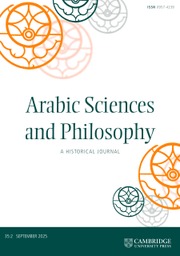Article contents
IBN RUSHD'S THEORY OF MINIMA NATURALIA
Published online by Cambridge University Press: 21 May 2002
Extract
The essence of the theory of minima naturalia is the contention that a physical body is not infinitely divisible qua that specific body. A drop of water cannot be divided again and again and still maintain its “wateriness”. There are several statements in Aristotle's Physics which suggest such an interpretation, and the theory of minima naturalia is commonly considered to have originated in the thirteenth century as an interpretation of these statements. The present paper is a preliminary presentation of the role of Ibn Rushd in the evolution of the theory, hitherto neglected. His theory developed not only as an elaboration on the “suitable” statements of Aristotle, but mainly as an attempt to solve the difficulties raised by Aristotle's thesis (developed in Physics VI and VII) that body and motion are continuous, infinitely divisible entities and are associated qua such. According to Ibn Rushd's interpretation, body and motion are associated not qua being continuous but qua having indivisible minimal parts. It seems that Epicurus' and Ibn Rushd's theories of minima developed as responses to Physics VI and offer modifications of classical atomism and of classical Aristotelianism (respectively), which to a certain extent reduce the gap between these two systems.
- Type
- Research Article
- Information
- Copyright
- © 2001 Cambridge University Press
- 5
- Cited by


